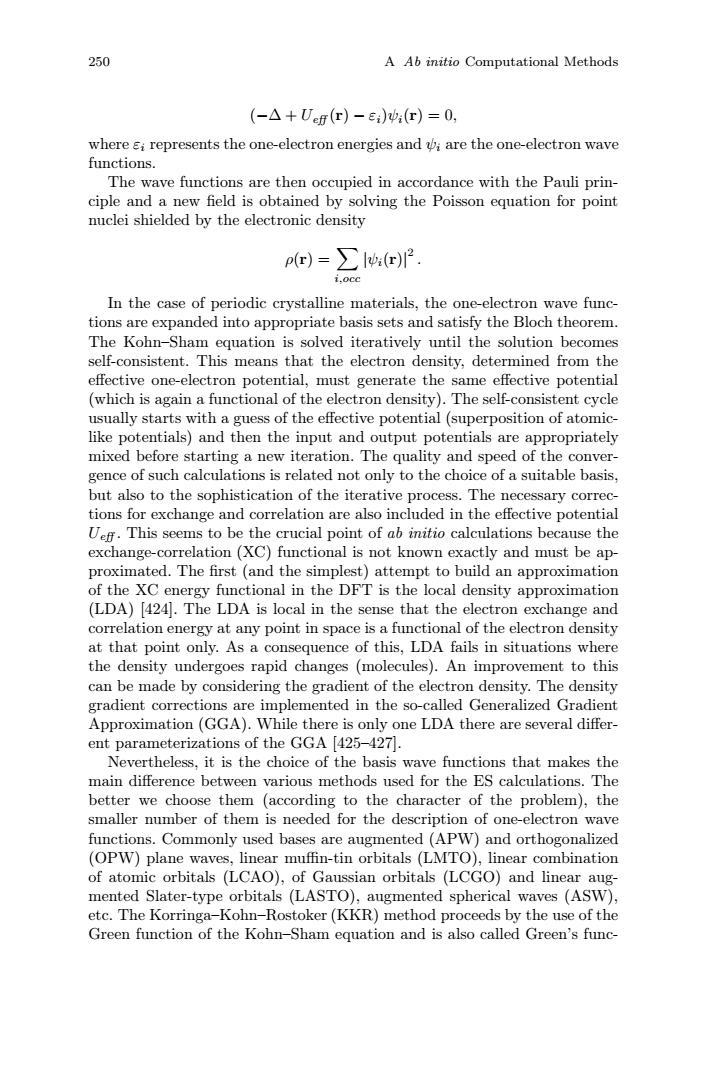正在加载图片...

250 A Ab initio Computational Methods (-△+Uef(r)-e)(r)=0, where si represents the one-electron energies and i are the one-electron wave functions. The wave functions are then occupied in accordance with the Pauli prin- ciple and a new field is obtained by solving the Poisson equation for point nuclei shielded by the electronic density p(r)=>lv:(r)2. i.occ In the case of periodic crystalline materials,the one-electron wave func- tions are expanded into appropriate basis sets and satisfy the Bloch theorem. The Kohn-Sham equation is solved iteratively until the solution becomes self-consistent.This means that the electron density,determined from the effective one-electron potential,must generate the same effective potential (which is again a functional of the electron density).The self-consistent cycle usually starts with a guess of the effective potential(superposition of atomic- like potentials)and then the input and output potentials are appropriately mixed before starting a new iteration.The quality and speed of the conver- gence of such calculations is related not only to the choice of a suitable basis but also to the sophistication of the iterative process.The necessary correc- tions for exchange and correlation are also included in the effective potential Uef.This seems to be the crucial point of ab initio calculations because the exchange-correlation(XC)functional is not known exactly and must be ap- proximated.The first (and the simplest)attempt to build an approximation of the XC energy functional in the DFT is the local density approximation (LDA)[424].The LDA is local in the sense that the electron exchange and correlation energy at any point in space is a functional of the electron density at that point only.As a consequence of this,LDA fails in situations where the density undergoes rapid changes (molecules).An improvement to this can be made by considering the gradient of the electron density.The density gradient corrections are implemented in the so-called Generalized Gradient Approximation(GGA).While there is only one LDA there are several differ- ent parameterizations of the GGA [425-427]. Nevertheless,it is the choice of the basis wave functions that makes the main difference between various methods used for the ES calculations.The better we choose them (according to the character of the problem),the smaller number of them is needed for the description of one-electron wave functions.Commonly used bases are augmented (APW)and orthogonalized (OPW)plane waves,linear muffin-tin orbitals (LMTO),linear combination of atomic orbitals (LCAO),of Gaussian orbitals (LCGO)and linear aug- mented Slater-type orbitals (LASTO),augmented spherical waves (ASW), etc.The Korringa-Kohn-Rostoker(KKR)method proceeds by the use of the Green function of the Kohn-Sham equation and is also called Green's func-250 A Ab initio Computational Methods (−Δ + Ueff (r) − εi)ψi(r)=0, where εi represents the one-electron energies and ψi are the one-electron wave functions. The wave functions are then occupied in accordance with the Pauli principle and a new field is obtained by solving the Poisson equation for point nuclei shielded by the electronic density ρ(r) = i,occ |ψi(r)| 2 . In the case of periodic crystalline materials, the one-electron wave functions are expanded into appropriate basis sets and satisfy the Bloch theorem. The Kohn–Sham equation is solved iteratively until the solution becomes self-consistent. This means that the electron density, determined from the effective one-electron potential, must generate the same effective potential (which is again a functional of the electron density). The self-consistent cycle usually starts with a guess of the effective potential (superposition of atomiclike potentials) and then the input and output potentials are appropriately mixed before starting a new iteration. The quality and speed of the convergence of such calculations is related not only to the choice of a suitable basis, but also to the sophistication of the iterative process. The necessary corrections for exchange and correlation are also included in the effective potential Ueff . This seems to be the crucial point of ab initio calculations because the exchange-correlation (XC) functional is not known exactly and must be approximated. The first (and the simplest) attempt to build an approximation of the XC energy functional in the DFT is the local density approximation (LDA) [424]. The LDA is local in the sense that the electron exchange and correlation energy at any point in space is a functional of the electron density at that point only. As a consequence of this, LDA fails in situations where the density undergoes rapid changes (molecules). An improvement to this can be made by considering the gradient of the electron density. The density gradient corrections are implemented in the so-called Generalized Gradient Approximation (GGA). While there is only one LDA there are several different parameterizations of the GGA [425–427]. Nevertheless, it is the choice of the basis wave functions that makes the main difference between various methods used for the ES calculations. The better we choose them (according to the character of the problem), the smaller number of them is needed for the description of one-electron wave functions. Commonly used bases are augmented (APW) and orthogonalized (OPW) plane waves, linear muffin-tin orbitals (LMTO), linear combination of atomic orbitals (LCAO), of Gaussian orbitals (LCGO) and linear augmented Slater-type orbitals (LASTO), augmented spherical waves (ASW), etc. The Korringa–Kohn–Rostoker (KKR) method proceeds by the use of the Green function of the Kohn–Sham equation and is also called Green’s func-